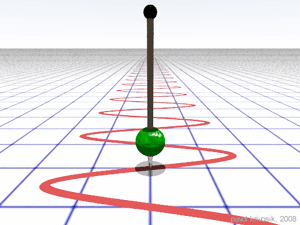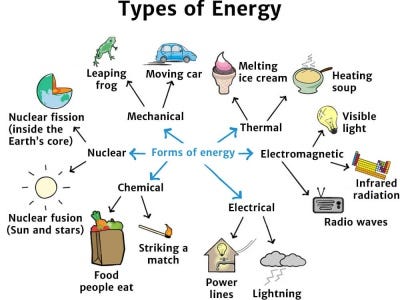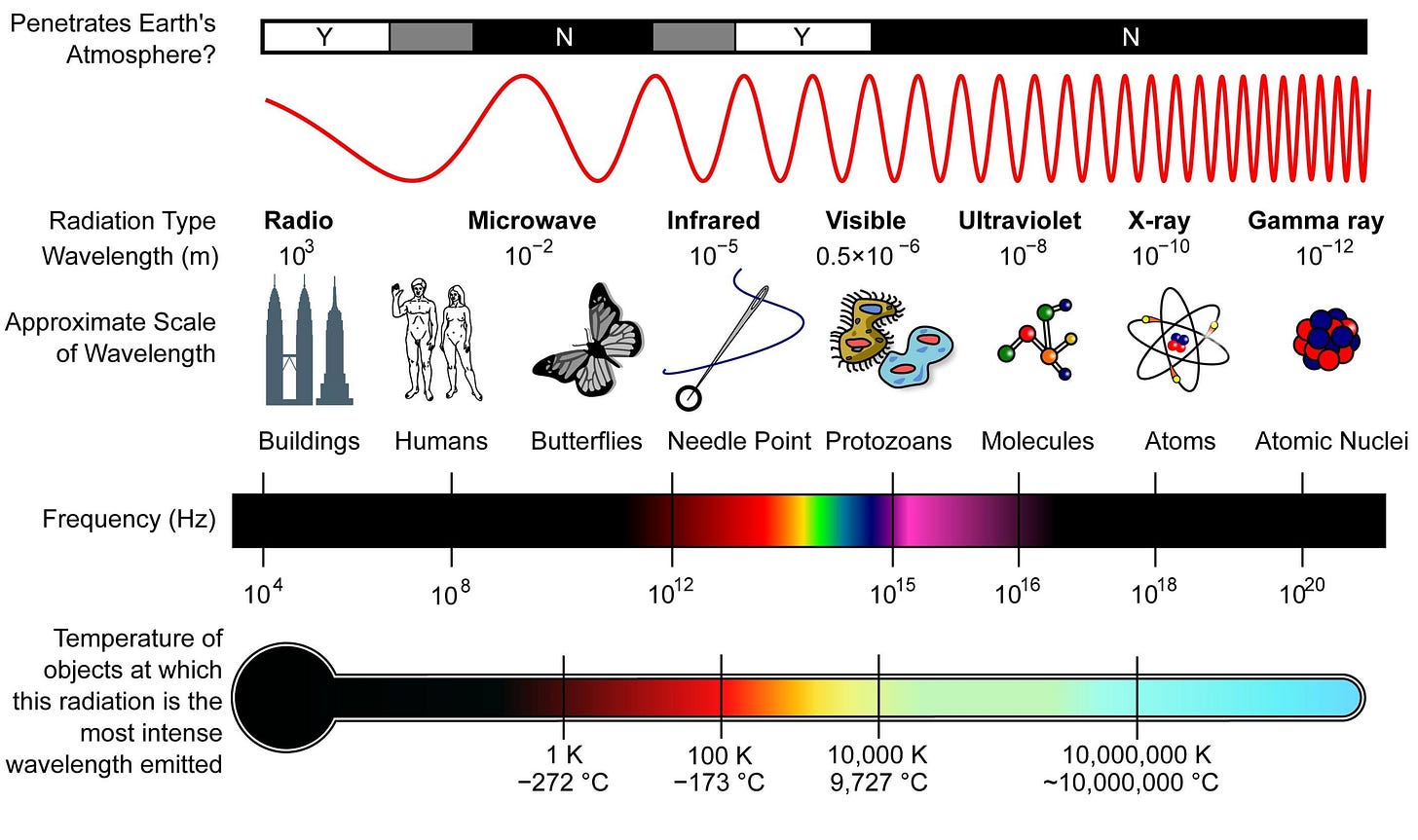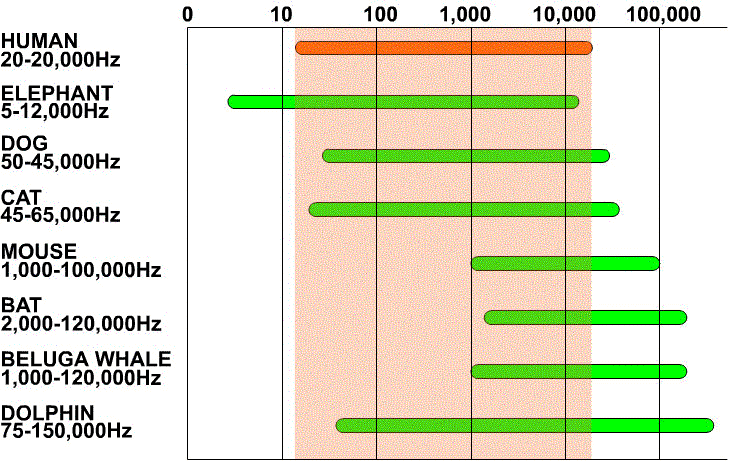Tuning into the Universe's Frequency (What Are Notes?)
"I would rather write 10,000 notes than a single letter of the alphabet." - Ludwig van Beethoven
I say to Beethoven:
What Are Notes?
In my very first podcast episode, I asked '“Why are there 12 notes?”
Silly me. I thought that was an appropriate beginning for the story of music. Instead, I should’ve been asking, what are notes?
Or better yet: What are frequencies?
Riding the Wave
All notes are frequencies. All frequencies are waves. In Wikipedia’s words, a “number of occurrences of a repeating event per unit of time.”
There are all sorts of waves. Sound waves. Light waves. Ocean waves. As a forever local of SoCal, I’m legally required to share this video:
Okay, I’m getting a little carried away with the GIFs. But the point I’m trying to make is: All waves are connected.
Guitarists Love String Theory
Space.com sums it up: “String theory is a theoretical physics concept that suggests that everything in the universe is made up of tiny vibrating strings that are smaller than atoms, electrons, or quarks. As these strings twist, fold, and vibrate, they create matter, energy, and other phenomena, such as gravity, electromagnetism, and particle physics. Humans interpret these effects as everything from large-scale phenomena to subatomic particles”
God’s a shredder?
Light Becomes Sound Becomes Light
If you have two minutes, check out this simple experiment converting sound into light and then back into sound:
Sound in Space?!
But of course, there’s no sound in the vacuum of space. But apparently there’s enough gas around the black hole that it can groan. Weird.
(There’s probably some other stuff going on though like shifting the frequencies into the range of human hearing.)
There are also other examples of the “music of the spheres,” where other oscillations are converted from one end of the wave spectrum waaaaaay over to the auditory spectrum.
You can do this with light, ocean waves, and even earthquakes!
So can we say we can “hear” the light? Or listen to the earth quake? Sorta. Idk. Something must be lost in translation.
But regardless it’s helpful for our understanding of how waves relate.
And it leads me to believe that audio is so human. We are not beings of light. We are beings of language. Of singing. Of drums. Of birdsong and myths!
In other words, bringing light down to the level of sound is kind of like turning bread into crumbs for us ants.
Microwaves and Nukes
Know the famous E = mc² equation?
It’s about creating equivalence between energy and mass. There’s a butt-ton of energy in mass, which is why you multiply the mass by the speed of light squared to find it.
Energy here is expressed as a wave.
Consider how a microwave excites the water molecules in your food and heats it. Or how a dirty bomb can give people cancer through Gamma rays:
And we can only see a small subset of these frequencies.
Check out the psychedelic world that bees see with their ultraviolet vision:
Same deal with hearing, but we’ve got a pretty broad swath of the spectrum covered. That’s why dog whistles and teen anti-loitering alarms work:
Naturally, our choice of musical notes corresponds to our hearing range. But imagine an alien species with a dolphin’s range of hearing. Wouldn’t their music be a trip? We’d probably have to scale it down just to perceive it. Maybe they’d be able to hear the earthquakes coming.
Feedback Loops (Feedback Loops, Feedback Loops)
Let’s check out another example of a conversion. Ever heard this sound at a concert or Jimi Hendrix recording?
That’s a speaker feedback loop. That’s where the frequency emitted by the speaker is returned to the speaker by the microphone, creating infinite recursion.
Here’s another example, a mirror facing a mirror:
Ready for the coolest one?
One of my best friends did some great research about seizures. When I asked him about it, he compared a seizure to a feedback loop: a recursion between electrical signals. The wave builds upon itself like the speaker and the microphone or the mirror pointed at another mirror.
And by understanding the wave, you’re able to intervene and stop the seizure. There are some tools to do this, but research is still ongoing.
(Converting these seizure waves to human hearing requires converting the pulses to audio and then raising their pitch by orders of magnitude. I hope Jordan makes his art installation some day.)
Converting Our Way to Understanding
I find waves easier to grasp when I consider them all as equivalent. It’s like looking at a problem from different angles. And it allows for a unique sort of creative thought.
For example, when I run a vocal into a feedback loop, I’m giving the computer a mini seizure. What am I saying with that? What emotional response does that elicit? It’s bigger than just adding “vibe.” It’s adding meaning beyond words.
We Can’t Grasp Light
The reason why it took Albert Einstein for humanity to grasp relativity wasn’t because there weren’t smart people around. It’s that the problem of light is deeply counterintuitive.
Sound is easier for us to grasp. We’re beings of sound. Of footsteps. Of wind. Of lion roars and wounded prey in the brush.
We’re Faster than Sound
Do you know the term, “Mach One?” That’s a measurement based on the speed of sound frequently used to describe rockets or jets.
One Mach = the speed of sound (around 761 mph at sea level on a standard day)
Heck, even I’ve flown over 700 mph in a passenger plane with a healthy tailwind. I was producing music at the time. Making sound at nearly the speed of sound!
There was even a plane that went Mach 9.6.
We’re Both Bound to a Medium
Unlike light, we cannot exist without the air around us. Sound is like us. It requiring a medium humanizes it. Makes it more familiar. And it behaves in more expected ways.
We can see the speakers vibrate. We can find the resonant frequencies of rooms just by ear. Or we can break glasses with our voice:
A Universe of Sound
Since we can understand audio more than light and can manipulate audio to great effect, I argue that music is our most powerful connection to the universe. I think there's more than cultural exchange or virtuosity in every note, in every frequency, in every wave.
Rhythm is order. Dance is communion. Harmonies are relationships incarnate. It’s bigger than that. It’s bigger than that black hole. It is the universe itself. And music is finding our place in it. It’s playing the strings of life itself.
So, What Is a Note?
Every frequency is valid. A note is just what we agree upon in an ensemble. In a future post, I’ll cover the 440 Hz vs 432 Hz debate, the history of different notes, and different cultures’ perspectives on tones. Here’s a taste:
Really, most of what we consider “in or out” of pitch is cultural and contextual. If the band is playing in 440, you better fit in!
There are also a ton of examples where tape has intentionally or unintentionally changed the pitch of a recording. Here’s one of my favorite examples: The Beatles’ Rain. Same song, same recording, but the pitch was manipulated via tape playback speed. Compare these two vids:
Notes Are Malleable; Notes Are Infinite
The composer can push off from or lean into any trope or cultural understanding. That’s the real power of knowing our history and the genre’s typical tuning.
I believe that there’s a freedom that comes from disconnecting the notes on the keyboard from all that is possible. There aren’t 12 notes. There’s an infinite gradient of frequencies. These frequencies settle into 12 familiar spots, but they are familiar by culture and history, not by their essential nature.
(In a future post, I’ll talk about why Western music landed on 12, the history of Pythagoras (the bean hater!), and all that jazz.)
How Do I Love Music More?
I hope you take this understanding and consider how frequencies, waves, light, and music interact.
How there is music in a sunset.
How gradients of frequencies can open our understanding.
How to look and listen to our world in a new way.
Thanks for reading, internet friend,
Scoob
P.S. Just dropped a new podcast episode with Aaron Comess of Spin Doctors!











I think it’s interesting that the wave builds upon itself like the speaker. And the reason Albert Einstein for humanity wasn’t because he wasn’t smart enough. Music is the world most powerful connection to the universe. Notes are the power of knowing people’s history and the genre’s typical tuning.
I think sound building on itself is interesting. I also like how he related string theory to notes. I liked the example of music being converted into light. The fact that music is constantly around us even if we cant hear it is so intriguing.